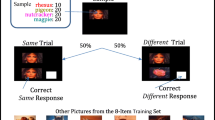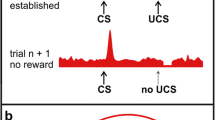Abstract
Twenty pigeons, divided into four groups, were trained to discriminate picture categories of birds and mammals in a natural-category experiment. Two groups were trained with 5 items from each category and two groups were trained with 35 items from each category. For one 5-item group and one 35-item group, stimuli were assigned according to bird (S+ set) and mammal (S− set) categories and for the other groups (5 and 35 items) the same stimuli were pseudorandomly assigned to an arbitrary S+ set and S− set. Groups with fewer items acquired the discrimination faster than groups with more items irrespective of item assignment. Only the 35-item category group, upon transfer to novel items, showed any evidence of concept learning. The 5- item category group learned its expanded 35-item discrimination in about one half the number of sessions required by the 5-item pseudocategory group to learn its expanded 35-item discrimination. The 5-item category group acquired the 35-item discrimination in fewer sessions than the original 35-item category group, indicating a savings attributable to first learning with few items. The 5-item pseudocategory group showed no savings in acquiring the 35-item discrimination relative to the original 35-item pseudocategory group. A continuum model of concept learning is suggested in which categorization is controlled by rote memorization of a few items, by exemplar processing when more items are involved, and by prototype processing when even more items are used.
Similar content being viewed by others
References
BHATT, R. S., WASSERMAN, E. A., REYNOLDS, Jr., W. F., & KNAUSS, K. S. (1988). Conceptual behavior in pigeons: Categorization of both familiar and novel examples from four classes of natural and artificial stimuli. Journal of Experimental Psychology: Animal Behavior Processes, 14, 219–234.
CERELLA, J. (1979). Visual classes and natural categories in the pigeon. Journal of Experimental Psychology: Human Perception and Performance, 5, 68–77.
CERELLA, J. (1982). Mechanisms of concept formation in the pigeon. In D. J. Ingle, M. A. Goodale, & R. J. W. Mansfield (Eds.), Analysis of visual behavior. Cambridge, MA: M. I. T. Press.
COOK, R. G., WRIGHT, A. A., & KENDRICK, D. F. (1990). Visual categorization by pigeons. In M. L. Commons, R. J. Herrnstein, S. M. Kosslyn, & D. B. Mumford (Eds.), Quantitative analysis of behavior: Behavioral approaches to recognition and concept formation. Hillsdale, NJ: Erlbaum..
EDWARDS, C. A., & HONIG, W. K. (1987). Memorization and “feature selection” in the acquisition of natural concepts in pigeons. Learning and Motivation, 18, 235–260.
ESTES, W. K. (1986). Memory storage and retrieval in category learning. Journal of Experimental Psychology: General, 115, 155–174.
GREENE, S. L. (1983). Feature memorization in pigeon concept formation. In M. L. Commons, R. J. Herrnstein, & A. R. Wagner (Eds.), Quantitative analysis of behavior: Discrimination processes. Cambridge, MA: Ballinger.
HARTER, J. (1979). Animals: 1419 copyright-free illustrations of mammals, birds, fish, insects, etc. New York: Dover.
HERRNSTEIN, R. J. (1979). Acquisition, generalization, and discrimination reversal of a natural concept. Journal of Experimental Psychology: Animal Behavior Processes, 5, 116–129.
HERRNSTEIN, R. J. (1985). Riddles of natural categorization. In L. Weiskrantz (Ed.), Animal intelligence: Proceedings of a Royal Society discussion meeting, held on 6 and 7 June, 1984. Oxford, England: Clarendon Press.
HERRNSTEIN, R. J., & De VILLIERS, P. A. (1980). Fish as a natural category for people and pigeons. In G. H. Bower (Ed.), The psychology of learning and motivation. New York: Academic Press.
HERRNSTEIN, R. J., LOVELAND, D. H., & CABLE, C. (1976). Natural concepts in pigeons. Journal of Experimental Psychology: Animal Behavior Processes, 2, 285–311.
HOMA, D. (1978). Abstraction of ill-defined form. Journal of Experimental Psychology: Human Learning and Memory, 4, 407–416.
HOMA, D., CROSS, J., CORNELL, D., GOLDMAN, D., & SCHWARTZ, S. (1973). Prototype abstraction and classification of new instances as a function of number of instances defining the prototype. Journal of Experimental Psychology, 101, 116–122.
HOMA, D., STERLING, S., & TREPEL, L. (1981). Limitations of exemplar-based generalization and the abstraction of categorical information. Journal of Experimental Psychology: Human Learning and Memory, 7, 418–439.
JACOBY, L. L., & BROOKS, L. R. (1984). Nonanalytic cognition: Memory, perception, and concept learning. In G. H. Bower (Ed.), The psychology of learning and motivation. New York: Academic Press.
KENDRICK, D. F., & RILLING, M. E. (1986). AIM: A theory of active and inactive memory. In D. F. Kendrick, M. E. Rilling, & M. R. Denny (Eds.), Theories of animal memory. Hillsdale, NJ: Erlbaum.
LOMBARDI, C. M., FACHINELLI, C. C., & DELIUS, J. D. (1984). Oddity of visual patterns conceptualized by pigeons. Animal Learning and Behavior, 12, 2–6.
MALLOTT, R. W., & SIDDALL, J. W. (1972). Acquisition of the people concept in pigeons. Psychological Reports, 31, 3–13.
MCCLELLAND, J. L, & RUMELHART, D. E. (1985). Distributed memory and the representation of general and specific information. Journal of Experimental Psychology: General, 114, 159–188.
MOON, L. E., & HARLOW, H. F. (1955). Analysis of oddity learning by rhesus monkeys. Journal of Comparative Physiological Psychology, 48, 188–194.
OMOHUNDRO, J. (1981). Recognition vs. classification of ill-defined category exemplars. Memory & Cognition, 9, 324–331.
OVERMAN, W. H., & DOTY, R. W. (1980). Prolonged visual memory in macaques and man. Neuroscience, 5, 1825–1831.
POOLE, J., & LANDER, D. G. (1971). The pigeon’s concept of pigeon. Psychonomie Science, 25, 157–158.
ROBERTS, W. A., & Mazmanian, D. S. (1988). Concept learning at different levels of abstraction by pigeons, monkeys, and people. Journal of Experimental Psychology: Animal Behavior Processes, 14, 247–260.
SANTIAGO, H. C., & WRIGHT, A. A. (1984). Pigeon memory: Same/different concept learning, serial probe recognition acquisition, and probe delay effects on the serial-position function. Journal of Experimental Psychology: Animal Behavior Processes, 10, 498–512.
SCHRIER, A. M., ANGARELLA, R., & POVAR, M. L. (1984). Studies of concept formation by stumptailed monkeys: Concepts humans, monkeys, and letter A. Journal of Experimental Psychology: Animal Behavior Processes, 10, 564–584.
SCHRIER, A. M., & BRADY, P. M. (1987). Categorization of natural stimuli by monkeys (Macaca mulatta): Effects of stimulus set size and modification of exemplars. Journal of Experimental Psychology: Animal Behavior Processes, 13, 136–143.
SHYAN, M. S., WRIGHT, A. A., COOK, R. G., & JITSUMORI, M. (1987). Acquisition of the auditory same/different task in a rhesus monkey. Bulletin of the Psychonomie Society, 25, 1–4.
SIEGEL, R. K., & HONIG, W. K. (1970). Pigeon concept formation: Successive and simultaneous acquisition. Journal of the Experimental Analysis of Behavior, 13, 385–390.
VAUGHAN, W., Jr., & GREENE, S. L. (1984). Pigeon visual memory capacity. Journal of Experimental Psychology: Animal Behavior Processes, 10, 256–271.
WAGNER, A. R. (1981). SOP: A model of automatic processing in animal behavior. In R. R. Miller & N. E. Spear (Eds.), Information processing in animal behavior: Memory mechanisms. Hillsdale, NJ: Erlbaum.
WASSERMAN, E. A., KIEDINGER, R. E., & BHATT, R. S. (1988). Conceptual behavior in pigeons: Categories, subcategories, and pseudocategories., 14, 235–246.
WRIGHT, A. A., COOK, R. G., RIVERA, J. J., SANDS, S. R, & DELIUS, J. D. (1988). Concept learning by pigeons: Matching-to-sample with trial-unique video stimuli. Animal Learning and Behavior, 16, 436–444.
WRIGHT, A. A., SANTIAGO, H. C., & SANDS, S. F. (1984). Monkey memory: Same/different concept learning, serial probe acquisition, and probe delay effects. Journal of Experimental Psychology: Animal Behavior Processes, 10, 513–529.
WRIGHT, A. A., SANTIAGO, H. C., URCUIOLI, P. J., & SANDS, S. F. (1984). Pigeon and monkey serial probe recognition: Acquisition, strategies, and serial position effects. In H. L. Roitblat, T. S. Bever, & H. S. Terrace (Eds.), Animal cognition. Hillsdale, NJ: Erlbaum.
Author information
Authors and Affiliations
Additional information
This research was supported by a grant from Mtsu to Donald F. Kendrick, by a Postdoctoral Fellowship, EY-05653, to Robert G. Cook, and by a grant, MH-35202, to Anthony A. Wright. We thank Daniel A. Newman for his help in conducting the experiment, and Mark Rilling and Michigan State University for providing space and pigeons for portions of the experiment.
Rights and permissions
About this article
Cite this article
Kendrick, D.F., Wright, A.A. & Cook, R.G. On the Role of Memory in Concept Learning by Pigeons. Psychol Rec 40, 359–371 (1990). https://doi.org/10.1007/BF03399546
Published:
Issue Date:
DOI: https://doi.org/10.1007/BF03399546




